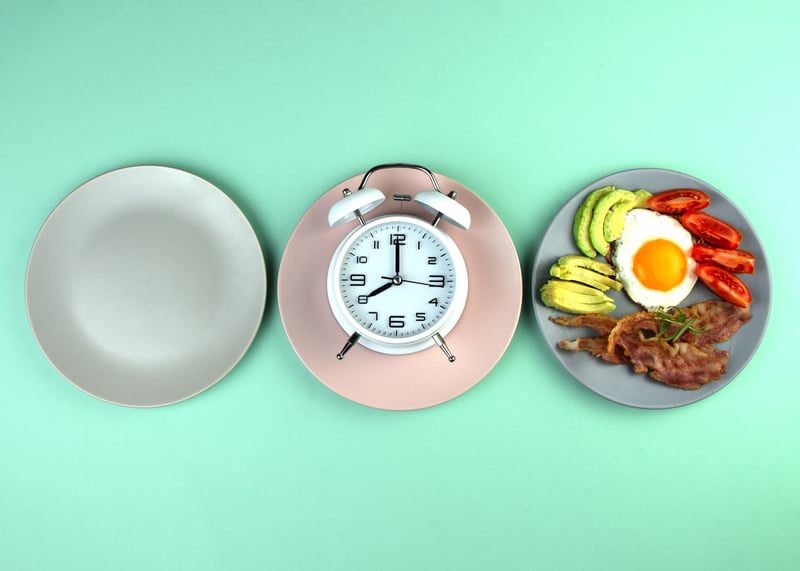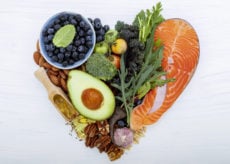I Did The One Meal a Day (OMAD) Diet For 7 Days…

Following in the footsteps of so many meal plans circulating the interweb today, intermittent fasting takes center stage once again in the OMAD diet. One Meal A Day may sound almost like starving, but tapping into autophagy may pose more benefits than risks for many people.
According to American neuroscientist Dr. Mark Mattson, in a research paper he published in the British medical journal The Lancet, eating one meal a day is the healthiest and most natural way of life.
Just ask professional wrestler/fighter Ronda Rousey. Think you could take her on in the ring? She sustains her energy for nine rounds by consuming just one meal a day, usually at/around dinner. Kind of the opposite of the argument that one must carb load to be at peak performance.
Three Square Meals… or One?
Where did the notion that we must consume three square meals a day become the norm anyway? Is breakfast still the most important meal of the day? If so, should that be your one meal?
The folks over at Harvard Health have said eating at least three times per day can keep you full and reduce hunger. This is allegedly the best option if your goal is weight loss. Their claim is that by eating fewer than three times a day, you’re at a higher risk for overeating and choosing less healthy foods due to hunger.
Of course, it’s not just a matter of when you eat but what. Quality food can help manage hunger and support weight loss. That’s why it’s important to eat foods like fruits and vegetables that fill you up with volume over calories, so you’ll feel fuller for longer. I think that’s the main takeaway with their thought process. But I am not necessarily sold that you must consume more than one meal to do so, provided your one meal consists primarily of nutrient-dense foods.
A paper published by the Department of Nutritional Sciences and Toxicology, University of California at Berkeley, showed how “alternate-day fasting regimens” significantly reduce cell proliferation rates. Cell death is considered a fundamental cause of the aging process, so the reduction of cell proliferation could slow down aging altogether by favoring the recycling, reducing, and rebuilding of younger cells.
I think we can all agree that there is no one-size-fits-all approach to meal planning or diet, and what works for one person may not necessarily work for another. That said, I’m always willing to give a new idea—especially a new diet like One Meal a Day—a trial run to see how well it works.
7 Days on the One Meal a Day Diet
So, what would an OMAD Diet look like in real life? I tried this meal plan for seven days, and here is how it went down.
NOTE: Before I begin, I must disclose that I am not a medical professional and do not recommend you adopt a new meal plan without first consulting your physician. This holds true especially for folks who may be taking prescription medications or are being treated for any health concerns.
That being said, the traditional protocol for the One Meal a Day Diet is to have the freedom to consume whatever you want, within reason, but only during one meal, which should last no longer than an hour. That sounds like a cheat meal, but if weight loss or living a healthy lifestyle is your thing, and it is MY thing, then you should continue to adhere to some guidelines. I typically avoid processed food, fast food, starchy foods, and sugars, and when I chose to begin this diet, I wanted to stay on track with my overall goals.
As with any meal plan, staying adequately hydrated is key. While following an OMAD Diet, drink plenty of water, coffee, or tea throughout the day. But avoid any other beverages. It’s also recommended that you eat your meal at the same time every day to ensure a consistent 23-hour fasting period. Finally, it’s important to consume enough calories to sustain your energy levels and keep hunger and cravings in check. I would recommend consuming your meal at the most active part of your day, which for me is after my children get home from school.
Day 1
For my one meal, I had leftover chili. I had prepared a huge crockpot of chili for Sunday football, and since it was made using all fresh ingredients and was somewhat healthy, I enjoyed a heaping bowl of it, sans cheese and sour cream. (Honestly, it didn’t need any of those extras.) Since I spent most of the day cheering on my favorite team alongside close friends and family, I was otherwise engaged and staying active, so it was almost as if I simply forgot to eat until it was time for chili. Admittedly, I usually indulge in a frosty beverage during the games, but not today.
Without my usual cup of coffee, and without all those extra calories weighing me down, at the end of the day, I was able to slip into a deep slumber relatively quickly.
Day 2
I woke up feeling rested and wasn’t immediately consumed with thoughts of “What’s for breakfast?” I prepared breakfast for my children and was able to make it out of the kitchen unscathed. I managed to go about my regular routine of work and monitoring online classes, along with chauffeuring to sports practices, without any hunger or cravings. When it came time for me to eat my one meal a day, I was torn between leftover chili or something else. Thus began the internal debate of not wanting to waste food but also being limited to just one meal—what would be my most favorite thing to eat? I gave this too much thought and ended up with chili. Off to bed!
BREAKING: US Doctor: “Eating This Every Day Can Snap You into Ketosis”
Day 3
I had already told myself I was not having chili and opted to package it up and deliver care packages complete with fresh homemade cornbread to a few neighbors. At least I wasn’t wasting food, right?
To my surprise, when it came time for my one meal, I was not even hungry. I have been drinking more water than normal, and it was keeping my stomach from grumbling. I went a little lighter and had a salad with shredded rotisserie chicken on top. It really hit the spot and left me feeling very satisfied.
Day 4
I found myself feeling pretty darn good! This was the first day it wasn’t raining cats and dogs, and I really needed to get out of the house for some exercise instead of making do with my indoor workout. I hit the beach and logged a few miles and was ready to then hit the ground running at work. Around a typical lunchtime, I started noticing I was already thinking about food. I tried to push the thought out of my head, but water just wasn’t cutting it. I threw myself deeper into my work, and after about 30 minutes, the hunger pangs had subsided, and I was able to make it to dinner (that is, my one meal). I went with a super classic combo of homemade tomato soup and grilled cheese. I was tasked with writing an article on soups for fall, and this was one I had just whipped up, and it was perfect—warming and comforting.
Day 5
It was back to torrential downpours in my neck of the woods, and the dark, grey skies were starting to wear on me. I always say your attitude determines your altitude, so I turned on some upbeat tunes to turn my frown upside down. I will admit that I would have assumed I would be irritable and possibly hangry from the reduced calories, but I noticed that it isn’t quite taking as much food for me to feel satiated. Only five days in, I was unable to finish my chicken for dinner. No worries as it will make for great leftovers!
Day 6
I was tasked with making a minestrone soup and could smell it cooking all day, and it was getting me excited for dinner. I did an extra workout today because I was trying to stay active and busy. In all the research I have done, it has been a common theme that strength training may be compromised when adhering to a fasting protocol. While I do like to lift heavy, I did not notice that my strength had diminished. However, I would be interested in seeing the long-term effects of consuming just one meal a day may have on my training.
Day 7
I was preparing for a birthday party and surrounded by kids’ party food. I wasn’t even phased by this and wasn’t tempted to sneak even a taste. Once again, I remained super active today and didn’t feel like I was missing out by not partaking in the food aspect of the celebrations. I had a hamburger with the bun for dinner, along with some coleslaw. Vinegar is my weakness, and it was a treat to have the coleslaw.
Final Thoughts on the OMAD Diet
Overall, I ended up six pounds lighter than I was just seven days earlier, and I feel great. I have participated in fasting off and on for a few years, so consuming just one meal a day was really not that difficult for me. I have found that when I start feeling hungry, if I just drink some water and give it 30 – 60 minutes, those feelings typically dissipate.
Is this a way of life I could see myself embracing long term? Probably not. Do I see a potential benefit? Well, to me, the benefit is that I really honed in on my own willpower and discipline. Would I recommend the OMAD Diet to everyone? As I mentioned earlier, there is no one-size-fits-all diet, but if you’re like me and up for a challenge, then go for it.
I often preach that the reason we eat is to live, rather than live to eat. This is definitely one way to put the focus back on whole, healthy, nutrient-dense foods and be mindful of what it takes to fuel our bodies.



 7 Signs Your Body is Seriously Low on Collagen (not just wrinkles)
7 Signs Your Body is Seriously Low on Collagen (not just wrinkles) Health Expert: "Turmeric Doesn't Work (unless...)"
Health Expert: "Turmeric Doesn't Work (unless...)" 3 Warning Signs Your Probiotic Supplement is a Total Waste
3 Warning Signs Your Probiotic Supplement is a Total Waste

